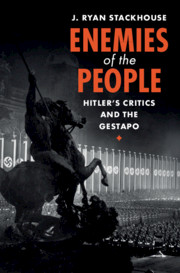Book contents
- Enemies of the People
- Enemies of the People
- Copyright page
- Dedication
- Contents
- Figures
- Tables
- Preface
- Acknowledgements
- Introduction
- 1 National and Regional Foundations, 1933–1945
- 2 Criminalizing Conversation, 1933–1934
- 3 Defining Opposition, 1935–1939
- 4 Discovering Offences, 1935–1943
- 5 Confirming Culpability, 1935–1943
- 6 Cooperation and Ascendancy, 1935–1939
- 7 Principles of Internal Security, 1939–1942
- 8 Enforcing People’s Community, 1939–1942
- 9 Total War Policing, 1943–1944
- 10 Involving the Party, 1943–1944
- 11 Death Throes, 1944–1945
- Epilogue
- Notes
- Bibliography
- Index
Introduction
A New Code of Law
Published online by Cambridge University Press: 08 October 2021
- Enemies of the People
- Enemies of the People
- Copyright page
- Dedication
- Contents
- Figures
- Tables
- Preface
- Acknowledgements
- Introduction
- 1 National and Regional Foundations, 1933–1945
- 2 Criminalizing Conversation, 1933–1934
- 3 Defining Opposition, 1935–1939
- 4 Discovering Offences, 1935–1943
- 5 Confirming Culpability, 1935–1943
- 6 Cooperation and Ascendancy, 1935–1939
- 7 Principles of Internal Security, 1939–1942
- 8 Enforcing People’s Community, 1939–1942
- 9 Total War Policing, 1943–1944
- 10 Involving the Party, 1943–1944
- 11 Death Throes, 1944–1945
- Epilogue
- Notes
- Bibliography
- Index
Summary
How did the Gestapo enforce laws governing criticism? Recent historiography highlights denunciation driven policing as well as the overrepresentation of Communists and Jews in cases taken to trial. A system of selective enforcement is well-established fact, but the dynamics remain unclear. Enemies of the People randomly samples two categories of “criminal opinion” to capture the changing decision-making processes behind routine investigation, interrogation, and enforcement practices. Five arguments take shape. First, a conscious policy of selective enforcement based on political reliability as defined by standing within the Nazi people’s community. Second, the system punished subversive motive rather than actions. Third, political police viewed targeted minorities as subversives, privileged minorities as supporters, and carefully investigated “politically colourless” Germans. Fourth, from 1935 to 1944, the Gestapo behaved as an ordinary detective service when investigating individual Germans. Fifth, selective enforcement involved state prosecutors and the Party through five configurations. The violence of revolution and collapse were bookends on a decade of much cooler suppression.
Keywords
- Type
- Chapter
- Information
- Enemies of the PeopleHitler's Critics and the Gestapo, pp. 1 - 26Publisher: Cambridge University PressPrint publication year: 2021

